
Oil painting is the process of painting with pigments with a medium of drying oil as the binder. It has been the most common technique for artistic painting on canvas, wood panel or copper for several centuries, spreading from Europe to the rest of the world. The advantages of oil for painting images include "greater flexibility, richer and denser colour, the use of layers, and a wider range from light to dark". But the process is slower, especially when one layer of paint needs to be allowed to dry before another is applied.

Impasto is a technique used in painting, where paint is laid on an area of the surface thickly, usually thick enough that the brush or painting-knife strokes are visible. Paint can also be mixed right on the canvas. When dry, impasto provides texture; the paint appears to be coming out of the canvas.

In painting, a pentimento is "the presence or emergence of earlier images, forms, or strokes that have been changed and painted over". Sometimes the English form "pentiment" is used, especially in older sources.

Portrait of Baldassare Castiglione is a c. 1514–1515 oil painting attributed to the Italian High Renaissance painter Raphael. Considered one of the great portraits of the Renaissance, it has an enduring influence. It depicts Raphael's friend, the diplomat and humanist Baldassare Castiglione, who is considered a quintessential example of the High Renaissance gentleman.

Rembrandt Harmenszoon van Rijn, usually simply known as Rembrandt, was a Dutch Golden Age painter, printmaker, and draughtsman. An innovative and prolific master in three media, he is generally considered one of the greatest visual artists in the history of art. It is estimated Rembrandt produced a total of about three hundred paintings, three hundred etchings, and two thousand drawings.

The Prodigal Son in the Brothel or The Prodigal Son in the Tavern or Rembrandt and Saskia in the parable of the prodigal son is a painting by the Dutch master Rembrandt. It is now in the Gemäldegalerie Alte Meister of Dresden, Germany. It is signed "REMBRANDT F.".

Self Portrait is an oil-on-canvas painting by the Dutch artist Rembrandt. Painted in 1652, it is one of more than 40 painted self-portraits by Rembrandt, and was the first he had painted since 1645. In composition it is different from his previous self-portraits, depicting the painter in a direct frontal pose, hands on his hips, and with an air of self-confidence. It was painted the year that his financial difficulties began, and breaks with the sumptuous finery he had worn in previous self-portraits. Art historian Christopher White has called it "one of the most magisterial and sombre of these (late) pictures". It is in the Kunsthistorisches Museum in Vienna.

Self-Portrait with Two Circles is an oil-on-canvas painting by the Dutch artist Rembrandt, painted c. 1665–1669, one of over 40 painted self-portraits by Rembrandt.

The dozens of self-portraits by Rembrandt were an important part of his oeuvre. Rembrandt created approaching one hundred self-portraits including over forty paintings, thirty-one etchings and about seven drawings; some remain uncertain as to the identity of either the subject or the artist, or the definition of a portrait.
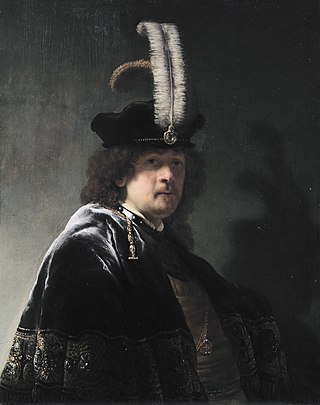
Self-portrait wearing a white feathered bonnet is an oil painting attributed to the Dutch painter Rembrandt. It is signed and dated 1635. It was traditionally regarded as a Rembrandt self-portrait until 1968, when it was rejected on stylistic grounds in the Rembrandt catalogue raisonné by Horst Gerson. In 2013, art historian Ernst van de Wetering re-attributed the painting as an original Rembrandt. It is one of over 40 painted self-portraits by Rembrandt.

A Polish Nobleman is a 1637 painting by Rembrandt depicting a man in a costume of Polish szlachta (nobility). The identity of the subject of the painting is unclear, and has given rise to several different interpretations. The view that the figure's dress is clearly Polish is not universally held and it may have been a self-portrait.
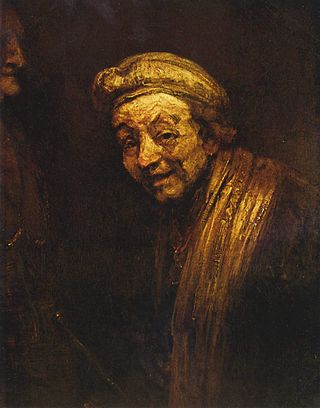
Self-portrait as Zeuxis Laughing is one of over 40 painted self-portraits by Rembrandt. Painted around 1662 by the Dutch artist Rembrandt, it is now in the Wallraf-Richartz-Museum in Cologne.

Self-Portrait at the Age of 63 is a self-portrait by the Dutch artist Rembrandt. One of three dating to 1669, it was one of the last in his series of around 80 self-portraits, painted in the months before his death in October 1669. Despite the closeness of his death, and the concentration on his aging face, Rembrandt makes an impression of a self-assured and confident artist. It was bought by the National Gallery, London in 1851.

The Portrait of Dirck van Os is a later painting by Rembrandt (1606–1669), created circa 1658. It is currently in the permanent collection of the Joslyn Art Museum in Omaha, Nebraska.
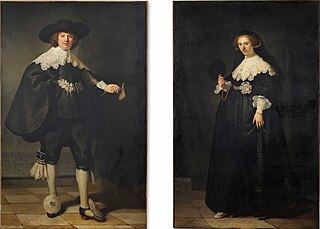
The pendant portraits of Maerten Soolmans and Oopjen Coppit are a pair of full-length wedding portraits by Rembrandt. They were painted on the occasion of the marriage of Maerten Soolmans and Oopjen Coppit in 1634. Formerly owned by the Rothschild family, they became jointly owned by the Louvre Museum and the Rijksmuseum in 2015 after both museums managed to contribute half of the purchase price of €160 million, a record for works by Rembrandt.

The Girl in a Picture Frame is a 1641 oil on panel painting by the Dutch artist Rembrandt. It is also known as The Jewish Bride and The Girl in a Hat. With The Scholar at the Lectern and Landscape with the Good Samaritan, it is one of three Rembrandt paintings in Polish collections. It is currently located at the Royal Castle in Warsaw.

Portrait of a Woman, probably a Member of the Van Beresteyn Family is a 1632 oil-on-canvas portrait painting by Rembrandt. A depiction of a woman with an unusually large millstone collar, it is a pendant to Portrait of a Man, probably a Member of the Van Beresteyn Family. Both portraits are in the collection of the Metropolitan Museum of Art.

The Preacher Eleazar Swalmius is a 1637 oil-on-canvas painting by the Dutch artist Rembrandt. It is currently owned by the Royal Museum of Fine Arts in Antwerp. The painting has been certified a real Rembrandt. The painting was listed in 1727 in the catalog of the Duke of Orléans collection, as a portrait of an Amsterdam mayor by Rembrandt. It remained in the noble family's possession until 1792, when Duke Louis-Philippe-Joseph sold the entire collection to finance his political career and pay off debts. The painting passed through several English collections into the hands of the Bourgeois brothers, art dealers from Cologne, who sold the painting as an original Rembrandt to the museum in 1886. The painting was stored away for a long time due to doubts cast over its authenticity.
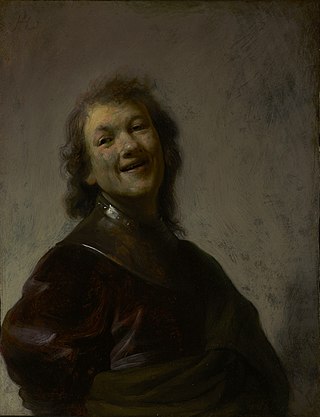
Rembrandt Laughing is a c. 1628 oil on copper painting by the Dutch painter Rembrandt van Rijn. It is an elaborate study of a laughing face, a tronie, and, since it represents the painter himself, one of over 40 self-portraits by Rembrandt, probably the earliest elaborate one. The painting, which was only recently discovered, is now in the J. Paul Getty Museum, California.
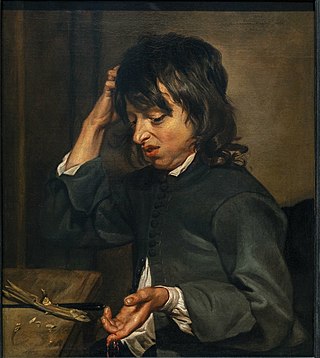
The Five Senses is a series of five paintings depicting allegories of sight, smell, taste, hearing, and touch, painted by Flemish artist Michaelina Wautier in 1650. Each sense is personified by a young boy. The paintings have been loaned to the Museum of Fine Arts, Boston, by their owners, Rose-Marie and Eijk van Otterloo.


























